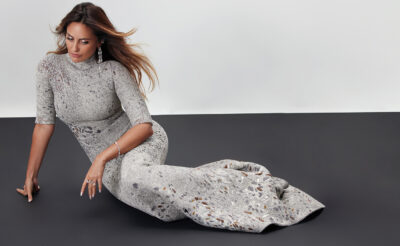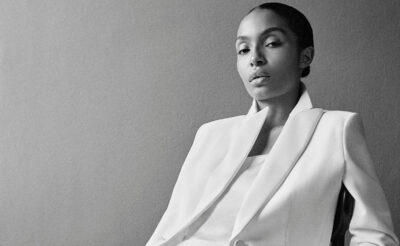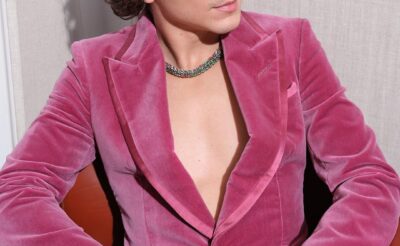From Chanel's Métiers d'Art and Valentino's Haute Couture to Marco de Vincenzo, fashion's focus has fallen on Rome, but why?
It was her wide smile that held me captive as she zipped along the cobbled streets of the ancient city. Wearing a silk necktie, a pristine white blouse and billowing midi-skirt, she sat poised on her Vespa – with her lover right behind her. She zoomed passed the historic architecture, leaving people lovingly indulging in gelato in her midst as she soaked the sun’s rays. She stuck out her legs like the spreading wings of a bird, and free-rolled down the winding roads. Filmed in 1953 in the iconic Cinecitta film studios, Audrey Hepburn and Gregory Peck have left a lasting impression of why it’s always good to take a Roman Holiday. From Alta Roma to Chanel’s Métiers d’Art, the city of Rome is experiencing a rebirth. It’s beginning to make Italy come alive again, and they’re serenading us with ‘la dolce vita’ once more.
During Haute Couture Fashion Week in July last year, it appeared as though designers had spent previous months circumnavigating the globe, scouring for creatively inspiring and dream-inducing locations – but not the Italians. They stayed put; and brought us a new Italy instead. Valentino’s haute couture show in Piazza Mignanelli – stretching out a runway from their historic atelier (along from the Spanish steps) in Rome – left the fashion crowd in awe. Roman designers Maria Grazia Chiuri and Pierpaolo Piccioli turned toward their beloved city and produced some very special clothes. From black Pagan gowns and opulent gold capes to gladiator sandals fit for goddesses, the historic treasures of their beloved city were evoked through decadent design. Speaking to MOJEH in July, they explained their concept: “In a way, we don’t want to show Rome, we want to allow people to experience Rome through our perspective. You can’t describe Rome with only words. It has many aspects,” said Pierpaolo. “The city is really the same as women are today: Multi-faceted. There are many aspects living together, floating together, whether monastic, sensual, aristocratic, sexy, gothic, dark.” You can feel their love in the rich patchworks inspired by the antique floors of the Eternal City and the exquisite craftsmanship. “We were both born in Rome and so, art is part of our lives. That’s why we find inspiration in it. All that we do is very close to us personally”, says Chiuri. “Art is a witness of our time,” adds Piccioli. “We believe that with fashion, you have to be a witness of your times too. It is the same thing with art, but in a different language.” It’s a fresh removal from Paris, and a (possible) spring toward a new fashion capital? Designers are investing more than just ateliers in the city. “It is an important moment for us. We are opening a school of couture in Rome and we are so proud to be able to bring the culture of couture into the future, because sometimes you think of couture and you think of something beautiful but belonging to the past,” explains Piccioli. But that’s the success behind Valentino, they manage to mystically merge the past with modernity through emotion.
Changes in the present, as the old guard move on, is making way for a new and energetic generation of young designers. And it’s a variegated list. Alessandro Michele’s recent revival of Gucci has had everyone talking, for all the right reasons. He’s skilfully managed to inject a quirkier edge to the label, illustrating a softer side to a label once considered to be flaying behind other storied Italian fashion houses. Residing in Rome, taking over from his recent predecessor and boss, Frida Giannini, Michele is a risk taker (as too are many of his other contemporaries following suit into this new found Roman limelight). Thinking of the Renaissance and the 1970s, in his collections for the brand he has fused a kaleidoscope of colours with girly gowns, new found geek-chic and a sartorial nod to vintage styling. In short: he’s changed our view of Italian dressing. As too has Marco de Vincenzo. He’s cleverly bypassed the signature Italian forte of mixing baroque with commercial sex appeal. Instead, he focuses on fusion and illusion. Shortly after graduating he joined Fendi, designing handbags while forging a working relationship with Silvia Venturini Fendi. Also based in Rome, he finds his daily inspiration from “everywhere and in every moment. Creativity is often unconscious.” It took LVMH four years to take an interest in his work, and now the fashion pack has taken notice too. If anything, he has a handle on how fabric should meander across women’s bodies with ease and elegance. His autumn/winter 15 collection used vibrant and vertical scaling across fabrics, and fringing edged numerable designs. de Vincenco is a master of embellishment and trickery, from cabochon studs on wool dresses to checkerboard-style contrasts on woven skirts, his technique is playful but romantic. Speaking to MOJEH in 2014, he explained his design process: “I produce everything in Italy and I personally go into every workshop which helps me to realise a new dream, every season. Being Italian consists of having no limits in experimentation and in quality. I try to take advantage of this privilege,” he said. He’s also got backing from Fendi (no surprises there).
In a way, we don’t want to show Rome, we want to allow people to experience Rome through our perspective. You can’t describe Rome with only words. It has many aspects
Pierpaolo Piccioli
Fendi, another storied Roman fashion house, they embody the heart and old soul of the city. During the Sixties and Seventies, Rome was full of couturiers and Fendi still invests in their craftsmanship today. Taking the old, but still looking to the new, the brand finds something in the city that other designers may overlook. As we’re all too aware by now, fashion is a means of expression – with emotion. “I think fashion should be a means of expression, so there’s always a human touch at Fendi because we don’t like to take things too seriously. We may be a traditional company with a big history, but we’ve always been about taking risks. We want our audience to find something new, so you’ll never go to a Fendi show and find a white room – instead we’re very lavish in the way we express our ideas and the meanings behind each collection,’ said Silvia speaking to MOJEH in 2014. In business since 1925, Fendi has collaborated closely with Karl Lagerfeld. Working with Silvia and her sisters, they’ve forged one of the longest standing design relationships in the industry. “There are no rules. I take ideas from him, he takes idea from me – it’s like osmosis,” she said. “He’s based in Paris and I’m in Milan, so often Karl will offer his ideas and then I’ll work each day to build on his references. I understand him very well now, so I know how to surprise him each time – to see the reaction in his eyes is something I’ve been trained to find. When he comes to Rome we only have a couple of days to pull everything together and make final selections, so we normally work through the nights and undoubtedly things will continue to change up until moments before the show.” Maybe this is why Karl took Chanel’s recent Métiers d’Art collection to the streets of Rome. Taking us back to the city’s Cinecitta, erecting a set the size of the Vatican City, the theatrics and fantastical elements were fully charged. But – Lagerfeld merged two beautiful cities together in harmony. Down the runway came a depiction of the Italian Renaissance woman with demi-beehives paired with colossal hoop earrings and fine black lace tights – all fused with her inner chic Parisian. Think: understated stripes, brocade tailored jackets and the classic Chanel pumps. It was an ode from Karl to Paris from Rome. It comes as no surprise as Lagerfeld has had a close relationship with the city since 1963, and after his debut season designing for Tiziani. And Coco too, who designed threads for Italian actresses, such as Jeanne Moreau, Anouk Aimée, Monica Vitti and Romy Schneider, each one starring in Italian films by Visconti and Pasolini, wearing her clothes. And Frederico Felini was there in spirit too as the show played out across Teatro 5. “It is just an idea, a dream, of Paris. We need to keep dreaming, because the reality in Paris is bleak. And that is not funny,” Karl told his crowd. The show went ahead after the Paris attacks in November last year, ultimately leaving a different city in its wake.
But there’s something metaphoric in his vision: could Rome act as a counterpart fashion capital to Paris? It’s very fitting for couture. Think of Giambattista Valli, another fellow Roman, who uses the exuberance of his native city in his visionary designs. Season after season, he produces gowns fit for goddesses and sets alight a runway with lavish fabrics, and exquisite delicate fabrics. Not just fashion, but jewellery too. The Bulgari family founded their luxury company in the city, and it’s still present there today. Could it be possible that other major designers would follow suit? Robert Cavalli and Emilio Pucci could up sticks and take to the streets of Rome from Florentine. But maybe if all roads could lead do Rome? Other designers could take to the city’s charms. Young emerging designers, who are keen to get a foothold on the ever-revolving fashion wheel – such as Nicolo Beretta, Carlo Volpi and Michele Chiocciolini – could find a place in the historic city. Imagine Rome as an annual stopover for the fashion critics and alike. Would it not be a visual delight away from the industrial horizon of Milan? They say a change can be as good as a rest. As Sarah Mower, Vogue.com’s chief critic, said: “And for the past decade, sorry to say, it’s felt like an emotionally dead time in Italian fashion. But not now!” In recent years it may have lost its sparkle, but a Roman Renaissance is upon us.



